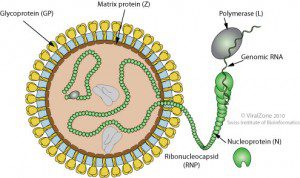

Guanarito virus is a member of the family Arenaviridae, which includes enveloped viruses with a segmented, negative-strand RNA genome. It is found in Venezuela where it is transmitted to humans from rats. The natural host is believed to be the short-tailed cane mouse. In humans the virus causes hemorrhagic fever with a case fatality rate of 23%. The virus does not transmit among humans and is not known to replicate in US rodents. Other viruses that cause hemorrhagic fevers include filoviruses, bunyaviruses, and flaviviruses.
It is believed that the missing vial of virus was inadvertently destroyed within the facility.
For an inside view of a BSL-4 laboratory, including a discussion of how virus stocks are secured, don’t miss ‘Threading the NEIDL‘, a documentary that explores the working of a similar facility in Boston, MA.

A one thing which is like a pain in the ass for the scientist :documentation for bio-safety check. I have the experience working only in BSL-3 Level in Japan. It was like hell, taking care of everything , in fact documentation is much more important than the experiment or the result itself. There should be some solution for this.
Of course that’s disturbing news, but kudos to UT for reporting the issue promptly. Transparency is crucial for facilities such as this. Just look at how badly Boston University got reamed a few years ago when they delayed reporting an apparent tularemia exposure in one of their labs. The memory of that incident is one of the reasons their BSL-4 facility has had such a chilly reception from the surrounding community.
Documentation for bio-safety checking is like a pain in the ass for a scientist. I have the experience working in BSL-3 level in Japan, It was like hell working and taking care of documenting all the vials. Documentation is considered to be more important than doing experiment and getting a result. It is very possible that under the work stress and experiment load the scientist can forget to document. There should be a way to treat this kind of problem, for example someone should be hired only for documentation and giving the vials to the scientist. It seems like an easy process to write down but everyone can forget under the heavy load of experiments, we are human beings for god sake.
as if they had a choice. would be insane to have a system in which BSL-4 had a choice pretty sure had they had a choice they would have pushed it under the rug believing “it was probably destroyed”. I hope they take away their BSL-4 licensing after this
Thing is, any lab that can “accidentally” destroy deadly viral stocks is a security threat in the sense that it is equally possible someone can steal said vile and sell it on the black market for a lot of dough. There should be no leniency in this, would be a security disaster to be lenient here
Sample/isolate management is a real challenge. There should be a dedicated staff member (a third party provider?) apart from the technical staff doing the lab work to do the documentation and inventory of samples.
The people who control a piece of information always have a choice about whether to disclose it. UT appears to have followed the proper procedure here, even though there must have been an immense temptation to cover it up. Mistakes happen. How we deal with them is what matters.
I agree, one to handle, one to document…it would be much more accurate and safe.